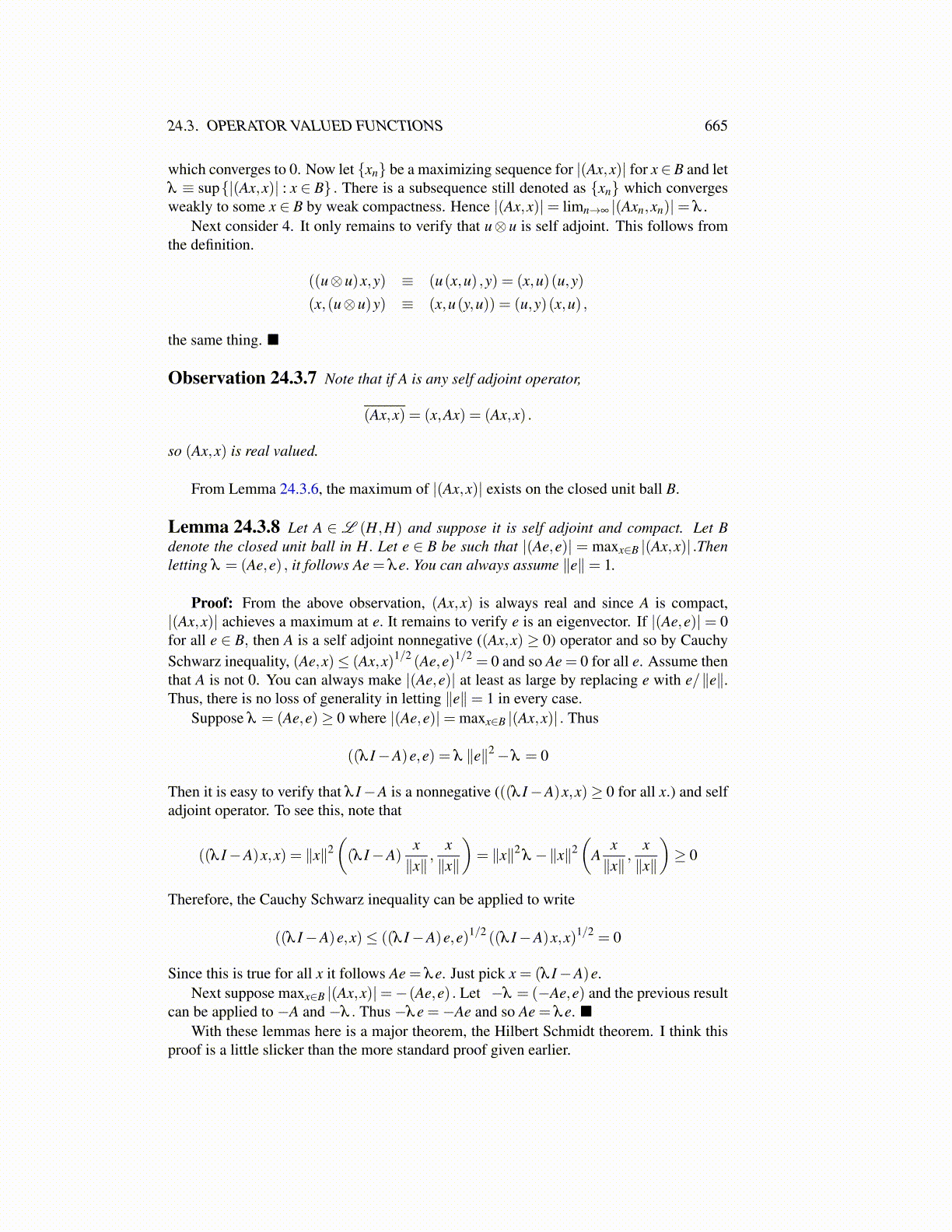
24.3. OPERATOR VALUED FUNCTIONS 665
which converges to 0. Now let {xn} be a maximizing sequence for |(Ax,x)| for x∈ B and letλ ≡ sup{|(Ax,x)| : x ∈ B} . There is a subsequence still denoted as {xn} which convergesweakly to some x ∈ B by weak compactness. Hence |(Ax,x)|= limn→∞ |(Axn,xn)|= λ .
Next consider 4. It only remains to verify that u⊗u is self adjoint. This follows fromthe definition.
((u⊗u)x,y) ≡ (u(x,u) ,y) = (x,u)(u,y)
(x,(u⊗u)y) ≡ (x,u(y,u)) = (u,y)(x,u) ,
the same thing. ■
Observation 24.3.7 Note that if A is any self adjoint operator,
(Ax,x) = (x,Ax) = (Ax,x) .
so (Ax,x) is real valued.
From Lemma 24.3.6, the maximum of |(Ax,x)| exists on the closed unit ball B.
Lemma 24.3.8 Let A ∈ L (H,H) and suppose it is self adjoint and compact. Let Bdenote the closed unit ball in H. Let e ∈ B be such that |(Ae,e)| = maxx∈B |(Ax,x)| .Thenletting λ = (Ae,e) , it follows Ae = λe. You can always assume ∥e∥= 1.
Proof: From the above observation, (Ax,x) is always real and since A is compact,|(Ax,x)| achieves a maximum at e. It remains to verify e is an eigenvector. If |(Ae,e)|= 0for all e ∈ B, then A is a self adjoint nonnegative ((Ax,x) ≥ 0) operator and so by CauchySchwarz inequality, (Ae,x)≤ (Ax,x)1/2 (Ae,e)1/2 = 0 and so Ae = 0 for all e. Assume thenthat A is not 0. You can always make |(Ae,e)| at least as large by replacing e with e/∥e∥.Thus, there is no loss of generality in letting ∥e∥= 1 in every case.
Suppose λ = (Ae,e)≥ 0 where |(Ae,e)|= maxx∈B |(Ax,x)| . Thus
((λ I−A)e,e) = λ ∥e∥2−λ = 0
Then it is easy to verify that λ I−A is a nonnegative (((λ I−A)x,x)≥ 0 for all x.) and selfadjoint operator. To see this, note that
((λ I−A)x,x) = ∥x∥2((λ I−A)
x∥x∥
,x∥x∥
)= ∥x∥2
λ −∥x∥2(
Ax∥x∥
,x∥x∥
)≥ 0
Therefore, the Cauchy Schwarz inequality can be applied to write
((λ I−A)e,x)≤ ((λ I−A)e,e)1/2 ((λ I−A)x,x)1/2 = 0
Since this is true for all x it follows Ae = λe. Just pick x = (λ I−A)e.Next suppose maxx∈B |(Ax,x)|=−(Ae,e) . Let −λ = (−Ae,e) and the previous result
can be applied to −A and −λ . Thus −λe =−Ae and so Ae = λe. ■With these lemmas here is a major theorem, the Hilbert Schmidt theorem. I think this
proof is a little slicker than the more standard proof given earlier.